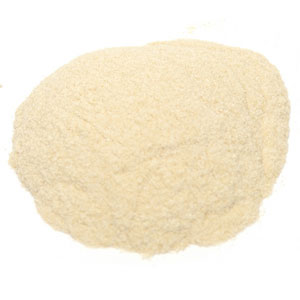Pectin facts for kids

Pectin is a heteropolysaccharide, a structural acid contained in the primary lamella, in the middle lamella, and in the cell walls of terrestrial plants. The principal chemical component of pectin is galacturonic acid (a sugar acid derived from galactose) which was isolated and described by Henri Braconnot in 1825. Commercially produced pectin is a white-to-light-brown powder, produced from citrus fruits for use as an edible gelling agent, especially in jams and jellies, dessert fillings, medications, and sweets; and as a food stabiliser in fruit juices and milk drinks, and as a source of dietary fiber.
History
Pectin was first isolated and described in 1825 by Henri Braconnot, though the action of pectin to make jams and marmalades was known long before. To obtain well-set jams from fruits that had little or only poor quality pectin, pectin-rich fruits or their extracts were mixed into the recipe.
During the Industrial Revolution, the makers of fruit preserves turned to producers of apple juice to obtain dried apple pomace that was cooked to extract pectin. Later, in the 1920s and 1930s, factories were built that commercially extracted pectin from dried apple pomace, and later citrus peel, in regions that produced apple juice in both the US and Europe.
Biology
Pectin is composed of complex polysaccharides that are present in the primary cell walls of a plant, and are abundant in the green parts of terrestrial plants. It is the principal component of the middle lamella, where it binds cells. Pectin is deposited by exocytosis into the cell wall via vesicles produced in the Golgi apparatus.
Pectin is an important cell wall polysaccharide that allows primary cell wall extension and plant growth. During fruit ripening, pectin is broken down by the enzymes pectinase and pectinesterase, in which process the fruit becomes softer as the middle lamellae break down and cells become separated from each other. A similar process of cell separation caused by the breakdown of pectin occurs in the abscission zone of the petioles of deciduous plants at leaf fall.
Consumption of pectin has been shown to slightly (3–7%) reduce blood LDL cholesterol levels. The effect depends upon the source of pectin; apple and citrus pectins were more effective than orange pulp fibre pectin. The mechanism appears to be an increase of viscosity in the intestinal tract, leading to a reduced absorption of cholesterol from bile or food. In the large intestine and colon, microorganisms degrade pectin and liberate short-chain fatty acids that have positive influence on health (prebiotic effect).
Sources and production
Pears, apples, guavas, quince, plums, gooseberries, and oranges and other citrus fruits contain large amounts of pectin, while soft fruits, like cherries, grapes, and strawberries, contain small amounts of pectin.
Typical levels of pectin in fresh fruits and vegetables are:
- Apples, 1–1.5%
- Apricots, 1%
- Cherries, 0.4%
- Oranges, 0.5–3.5%
- Carrots 1.4%
- Citrus peels, 30%
- Rose hips, 15%
The main raw materials for pectin production are dried citrus peels or apple pomace, both by-products of juice production. Pomace from sugar beets is also used to a small extent.
From these materials, pectin is extracted by adding hot dilute acid at pH values from 1.5 to 3.5. During several hours of extraction, the protopectin loses some of its branching and chain length and goes into solution. After filtering, the extract is concentrated in a vacuum and the pectin is then precipitated by adding ethanol or isopropanol.
Alcohol-precipitated pectin is then separated, washed, and dried. After drying and milling, pectin is usually standardised with sugar, and sometimes calcium salts or organic acids.
Uses
The main use for pectin is as a gelling agent, thickening agent and stabiliser in food.
In some countries, pectin is also available as a solution or an extract, or as a blended powder, for home jam making.
The classical application is giving the jelly-like consistency to jams or marmalades, which would otherwise be sweet juices. Pectin can also be used to stabilise acidic protein drinks, such as drinking yogurt, to improve the mouth-feel and the pulp stability in juice based drinks and as a fat substitute in baked goods.
Typical levels of pectin used as a food additive are between 0.5 and 1.0% – this is about the same amount of pectin as in fresh fruit.
In medicine, pectin increases viscosity and volume of stool so that it is used against constipation and diarrhea. Until 2002, it was one of the main ingredients used in Kaopectate – a medication to combat diarrhea – along with kaolinite. It has been used in gentle heavy metal removal from biological systems. Pectin is also used in throat lozenges as a demulcent.
In cosmetic products, pectin acts as a stabiliser. Pectin is also used in wound healing preparations and speciality medical adhesives, such as colostomy devices.
Interesting facts about pectin
- Pectin is a soluble dietary fiber. It binds to cholesterol in the gastrointestinal tract and slows glucose absorption by trapping carbohydrates.
- The amount, structure and chemical composition of pectin is different among plants, within a plant over time, and in various parts of a plant.
- Pectin was first sold as a liquid extract, but is now most often used as dried powder, which is easier than a liquid to store and handle.
- The daily intake of pectin from fruits and vegetables can be estimated to be around 5 g if approximately 500 g of fruits and vegetables are consumed per day.
- Pectins are rich in galacturonic acid.
See also
 In Spanish: Pectina para niños
In Spanish: Pectina para niños
- Fruit snacks


